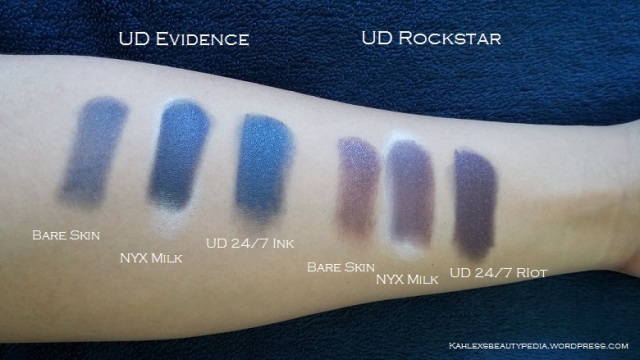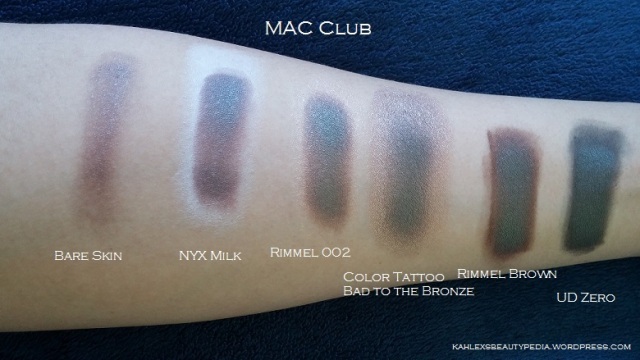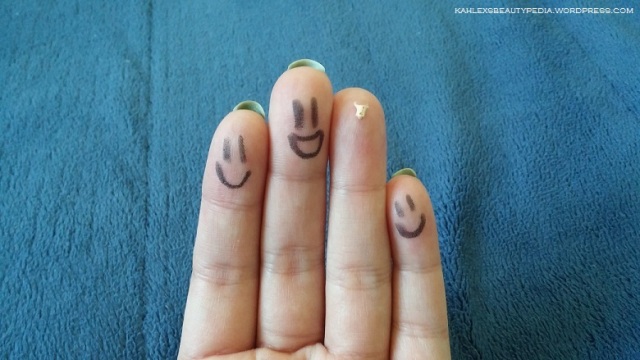Whether you are a makeup expert or a makeup dabbler, you have probably seen or heard people writing or talking about how they use an eye shadow base and/or an eye shadow primer. But what is the difference? Can you get away with only using one or the other? Should you use both? What do they do, anyway? Do not fear; I am here to answer all of your questions!
Eye Shadow Primer
What is it?
Eye shadow primer is a lightweight, thin, creamy liquid that is applied directly to the eyelids to prepare the eyelids for eye shadow application. It typically blends out to be invisible, but some are meant to even out discoloration that naturally occurs on some people’s eyelids (most people will use an eye base for this; eye bases will be discussed below). Eye shadow primer creates a smooth, tacky surface on the eyelid that helps powder eye shadows adhere better to the skin of the eyelid, improving pigmentation and staying power (i.e. prevents your eye shadow from fading throughout the day). Eye shadow primer also acts as a barrier between the skin of your eyelids and your eye shadow, preventing your sebum (i.e. oils naturally produced by your skin) from mixing with the eye shadow and creasing (i.e. creases appearing in your eye shadow during the day as the result of blinking and normal eye movements). Basically, an eye shadow primer will 1) improve the pigmentation of your eye shadows, 2) keep your eye shadow on all day without fading, and 3) prevent your eye shadow from creasing.
You Want To Use a Primer If:
- You are dissatisfied with the pigmentation of your eye shadows;
- Your eye shadow does not last throughout the day without fading;
- You have oily and/or sweaty eyelids; and/or
- Your eye shadow creases before you are done with your day.
Alternatively, if your lids are not particularly oily, you can use a very small amount of foundation as primer to help with your eye shadows’ pigmentation.
How to Use:
- If you are using an eye shadow primer with a doe-foot applicator/wand, then dab it onto your lids (or dab onto your finger, then dab onto lids; if using a squeeze tube, then squeeze out about a drop of primer, then dab onto lids), then blend with your ring finger (your gentlest touch) all over your lids. Cover the entire area where you plan on putting any eye shadow, from your lash line up to your brow bone if you put eye shadow all the way up there (as a highlight, or whatever). Use a nice, thin layer. You don’t need to be piling this on. Also, apply to the lower lash line if you plan on using any liner on your lower lash line. Some people use eye shadow primer under their eyes to keep their under-eye concealer from creasing. If you have problems with your under-eye concealer creasing you can place this everywhere you put your under-eye concealer (i.e. under your eyes… I know… shocking!)
- Wait for it to dry. You want it to be dry because if you apply shadow over wet primer, it will be patchy and difficult to blend. It should only take a few seconds for the primer to dry. Make kissy faces in your mirror, pee, rock out to a song, or all of the above (hey, I won’t judge you).
- Make sure your eyelids no longer feel wet from freshly-applied eye shadow primer.
- Apply eye shadow. Some people like to start by applying a layer of eye shadow that matches their skin tone all over first so that blending is easier (also, some people like to do this as an alternative to using a base). You can apply eye shadow however you like. The sky’s the limit!
What Primer(s) Do I Recommend?
This is an immensely difficult topic. Because cosmetics are so personal, different products work differently for different people. All I can really do is to point you to these two blog posts from Brightest Bulb In the Box, showing how well particular primers performed with regard to eye shadow pigmentation and fading after four hours on her arm:
You can see in her swatches how primer improves the pigmentation of the eye shadow and helps with fading.
If you are using an eye shadow primer, but your eye shadow is still creasing, there are a few possibilities:
1. You are using too much primer; or
2. It is not The One Primer for you. This happens. Not every product works for everybody, and that is fine. We can’t all be friends, sadly.
Eye Shadow Bases
What is it?
Eye shadow base is a thicker, creamier product. Its primary purpose is to intensify the color of eye shadow by providing a base for the powder to adhere to. For example, if you want to use purple eye shadow, you would use a purple base underneath the purple powder eye shadow to make it extra purple. Because it provides a sticky base for eye shadow to adhere to, it helps keep your eye shadow from fading the same way a primer does. For example:

The colored bases were Urban Decay 24/7 Glide-On Eye Pencils from the Black Market set that was sold for the 2013 holidays.
You can see that the white base helped the eye shadows show up more blue or purple, respectively. The base that (approximately) matched the eye shadows intensified the pigmentation greatly and added some incredible sheen that you cannot see in the swatches on bare skin.
Using different bases can change the way duochrome eye shadows look. A darker base will help the “other color” to show up more. A demonstration using MAC Club:

MAC Club on bare skin and over NYX Jumbo Eye Pencil in Milk, Rimmel Scandal Eyes Eye Shadow Stick in 002 Bulletproof Beige, Maybelline Color Tattoo in Bad to the Bronze, Rimmel Scandal Eyes Kohl Kajal eyeliner in 003 Brown, and UD 24/7 Glide-On Eye Pencil in Zero. I purposely left some of the base visible around each eye shadow swatch so you could see the color of the base. I’ll have you know I’m actually excellent at coloring inside the lines (passed kindergarten with flying colors)!
You can see that on bare skin, Club looks brown. With different bases, that blackish-green duochrome is more apparent.You can see that Club over the black base is just the blackish-green color. No brown at all. Absolutely gorgeous.
However, due to the creamier texture, eye shadow bases often crease, unlike primers, which help prevent creasing.
Another use for an eye shadow base is to even out discoloration in your eyelids. The skin on your eyelids is often very thin, so sometimes, blood vessels can discolor your eyelids. If you use a base that is the same color as your skin, or a color-correcting color (i.e. green to cancel out reds, or salmon/yellow to cancel out blue/purple), you can eliminate the effect of discoloration on your eye shadow. You can use a concealer for this purpose.
You Want To Use a Base If:
- You want your eye shadow colors to show up more true-to-color; and/or
- You want to cancel out discoloration in your eyelids that may be affecting how colors look on your eyelids.
How to Use:
- Apply to lids. It is difficult to give guidelines regarding amount, because I usually just scribble on my lid (if using pencil) or dab my finger into cream shadow until I have “enough.”
- Blend it out so it’s evenly distributed wherever you want it. Use your ring finger again (be gentle on your delicate eye area). You want to keep it to a pretty thin layer to minimize creasing. I typically use my fingers and rub (gently), but you can use a brush if you prefer. Give them a few seconds to set.
- Apply eye shadow. Enjoy your intensified color.
What Base(s) Do I Recommend?
This is, again, a difficult question because cosmetics are so personal and results may vary. However, you can use pretty much any cream eye product, including cream eye shadows and even eyeliners. Some popular ones include MAC Paint Pots, Make Up For Ever Aqua Cream, Maybelline Color Tattoos, and NYX Jumbo Eye Pencils.
If you experience creasing while using a base, you may be applying too much base. Try using less. Just the minimal amount to cover the area in a thin layer.
Can You Use Both a Primer and a Base?
Of course you can! The primer will help keep the base (and your eye shadows) from creasing. Both the primer and base will intensify the color payoff of your eye shadows and enhance its lasting power. You would apply the primer first, then the base, then your eye shadow(s).
Do You NEEEEEEEEEEED To Use a Primer And/Or Base?
Of course not. You do not need to wear any makeup. But if you are dissatisfied with the pigmentation of your eye shadows or experiencing fading or creasing early in the day, they are certainly helpful.
I hope this has been helpful! I know that cosmetics companies often name products differently, but the way that you use them does not change. For example, NARS Smudge Proof Eye Base is a primer, even though it is called a base. Feel free to leave comments, questions, and feedback below!


Great stuff! Can you make a post regarding cleaning your brushes daily? (Promote it at /r/makeupaddiction)
I’m currently working on a post about foundation application (as a companion to my recent post on foundation selection), but I will definitely add your suggestion to my list. Thank you!